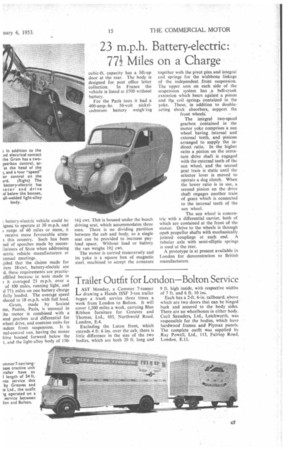23 m.p.h. Battery-electric: 771. Miles on a Charge
Page 45

If you've noticed an error in this article please click here to report it so we can fix it.
battery-electric vehicle could be igneci to operate at 30 m.p.h. and range of 60 miles or more, it receive more favourable attenthis country. Such has been :rid of speeches made by succeslinisters of State when addressing ectric vehicle manufacturers at nnual meetings.
tided that the claims made for ram 18-cwt. battery-electric are d, these requirements are practicanted because in tests made in t it averaged 23 m.p.h. over a
of 100 miles, running light, and d 771 miles on one battery charge fully loaded. The average speed :duced to 18 m.p.h. with full load.
Gram, made by Societe me, Pantin, Paris, is unusual in the motor is combined with a teed gearbox and differential for wheel drive, and contains units for indent front suspension. It is nal-control van, having the motor !rive housed forward below the I. and the light-alloy body of 110 cubic-ft. capacity has a lift-up door at the rear. The body is designed for post office letter collection. In France the vehicle is listed at £500 without battery.
For the Paris tests it had a 400-amp.-hr. 50-volt nickelcadmium battery weigh 'ing 16.1 cm. This is housed under the bench driving scat, which accommodates three men. There is no dividing partition between the cab and body, so a single seat can be provided to increase payload space. Without load or battery the van weighs 191 cwt.
The motor is carried transversely and its yoke is a square box of magnetic steel, machined to accept the armature together with the pivot pins and integral coil springs for the wishbone linkage of the independent front suspension. The upper arm on each side of the suspension system has a bell-crank extension which bears against a piston and the coil springs contained in the yoke. These, in addition to doubleacting shock absorbers, support the front wheels: The integral two-speed gearbox contained in the motor yoke comprises a sun wheel having internal and external teeth, and pinions arranged to supply the indirect ratio. In the higher ratio a pinion on the armature drive shaft is engaged with the external teeth of the sun wheel, and the second gear train is static until the selector lever is moved to operate a dog clutch. When the lower ratio is in use, a second pinion on the drive shaft engages another train of gears which is connected to the internal teeth of the sun wheel.
The sun wheel is concentric with a differential carrier, both of which are contained at the front of the motor. Drive to the wheels is through opeh propeller shafts with mechanically jointed couplings at each end. A tubular axle with semi-elliptic springs is used at the rear.
A prototype is at present available in London for demonstration to British manufacturers.




























































































